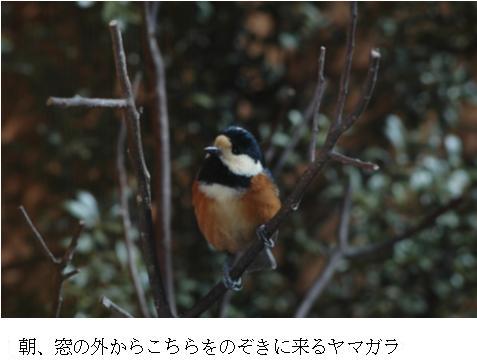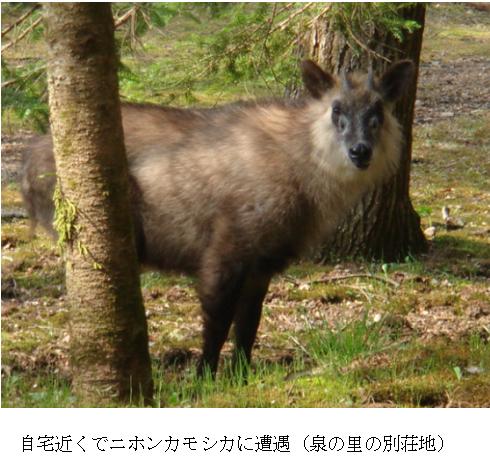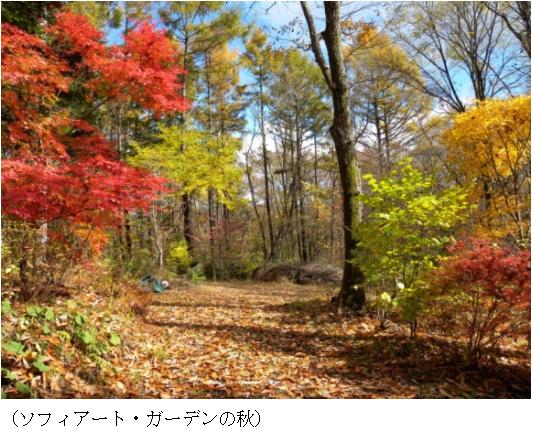
私はソフィアートのスタッフMと申します。表向きはヒトとして生きておりますが、鳥のほうに感性が近いと感じることが、しばしばあります。(スタッフMの略歴は >>こちら です)
ソフィアート・ガーデン物語にお越しくださり、ありがとうございます。
ご覧いただいた方の中には、意味がわからないとか、価値観が違うなどと首を傾げることもありましょうが、私どもが撮った写真とともに、いろいろな角度からソフィアート・ガーデンを紹介していきます。
ところで、ソフィアート・ガーデンとは何でしょう?

弊社ソフィアートは、長野県の軽井沢町という標高1000メートルの高原にあります。
軽井沢は避暑地として知られているとおり、夏は涼しく、冬はとても寒い土地です。気象庁などのサイトで平均気温や最高最低気温などを眺めていただければ、夏は北海道の札幌並みかそれ以上に涼しく、冬は同じように寒いところであることに驚かれることでしょう。近年は温かくなったそうですが、今年の冬も氷点下18.9度を記録しました。もっとも北海道や本州日本海側と違ってあまり雪は降りません。
たまに噴火する浅間山の影響を強く受けた自然豊かな土地で、四季のめぐりの恵みに感謝して過ごしています。

ご存知の方も多いでしょうが、軽井沢は日本有数の野鳥生息地です。また、野生動物が庭や近隣の散歩道を横切るようなワイルドな土地でもあります。たとえば私が複数回遭遇した野生動物だけでも、イノシシ、ツキノワグマ、サル、ニホンカモシカ、キツネ、タヌキ、ムササビ、リス、アカネズミ、ハクビシン、アライグマなどがいます。また直接遭遇はしていませんがヤマネもいます。そのほかさまざまな未確認生物もいるかもしれません・・・。人間が野生動物の領域にお邪魔しているような住環境ですので、ちょっとした散歩でも見通しの悪い場所では、まずはクマ鈴を鳴らし、全身の感性を研ぎ澄まして散歩しています。人間と野生動物のお互いの幸せのために。
ところで私の趣味は樹木を観察することです。パートナーとともに、ここ8年間で100種類以上の樹木を500本以上植え、育てています。重機なしでスコップ、長靴、時にはヘルメット姿であくまで「人力」で頑張ります。高さ10メートル級の樹木の移植はさすがに専門の植木屋さんにクレーンやユニック、バックホウなどでお願いしましたが、3、4メートルまでの樹木なら、素人ながらパートナーと私の2人が軽トラックで運んで植えてきました。余談ですが、そうした作業が筋トレとして作用したのか、最近の人間ドックで私は上半身の腕力がアスリート並み、という評価をもらいました。腕力だけはあるようです。
こういった趣味が嵩じて、日本全国、行く先々で、まず樹木や草花に目が留まるようになりました。植物をひたすらじーっと観察していると、実に様々なことが分かります。土地の植生から、その土地の持つ性質が見えてきます。日当たり、風通し、土の水分、肥沃さ、といった植物の育ち具合からわかる性質だけでなく、果てはその土地が人を元気にする土地かどうかまで、気のせいかもしれませんが見えてくるように思います。そうした目に見えるものから目に見えない兆しを意識して観察することを、10年近く続けるうちに「土地の気」というものに敏感になりました。気持ちよくて思わず長居したくなる土地、その反対に息苦しい感じがして走って逃げたくなる土地、さまざまな土地があることに気づき、おもしろくもあり驚きもあります。こうした気づきを得られることもあり、樹木の観察は楽しくてやめられません。「木」は、見えない「気」を具現化して見せてくれるものだと思っています。

そして、なにより樹木は、野鳥に来てもらい、遊んでもらうために必須です。これこそ私どもが樹木を植える真の目的です。
したがって植える樹木は土地の在来種を中心に、野鳥が実を食べたり営巣の材に使ったり等、鳥にとって魅力ある木を植えてきました。当然のことながら、日当たり風通し、土の水分や肥沃さなど樹木の生育のための条件を十分に吟味したうえで、数年がかりで土地を観察して決めていきます。こうして、コツコツと整え、何より野鳥の行動や好みを徹底的に観察、研究して作ってきた庭を、私どもは「ソフィアート・ガーデン」と仮に名づけて皆様に紹介したいと思います。樹種やそれぞれの四季に織り成す変化の姿を少しずつお知らせします。
※ソフィアート・ガーデンは弊社オフィスからちょっと離れた場所にあります。私有地のため一般公開はしておりません。
『 ソフィアート・ガーデン物語 』 序 「案内係のMです」
有限会社ソフィアート スタッフM( 竺原 みき )
The Tale of Sophiart Garden
>>To the Next Story
Prologue
"Welcome to Sophiart Garden. I am M, your guide."
April 9, 2012
I am M, a staff member of Sophiart. Outwardly, I live as a human, yet I often feel my sensibilities are closer to those of a bird. (For more about my background, click here.)
Thank you for visiting The Tale of Sophiart Garden. Some of you may find yourselves puzzled, unable to grasp the meaning of what you see, or perhaps you feel it does not align with your values. Nonetheless, through the photographs we have taken, I hope to introduce Sophiart Garden from various perspectives.
But first, what exactly is Sophiart Garden?
About Sophiart Garden
Sophiart is located in Karuizawa, a highland town in Nagano Prefecture, standing at an elevation of 1,000 meters. As a well-known summer retreat, Karuizawa enjoys cool summers and extremely cold winters. If you check meteorological data, you may be surprised to find that its summer temperatures rival, or even fall below, those of Sapporo in Hokkaido, while its winters are just as harsh. In recent years, the climate has warmed somewhat, yet this past winter, temperatures still dropped to -18.9°C. However, unlike Hokkaido or the coastal regions of the Sea of Japan, heavy snowfall is rare here.
Nestled in the embrace of the ever-active Mount Asama, the land is rich in nature, and we live in gratitude for the blessings of the four seasons.
Many of you may already know that Karuizawa is one of Japan’s premier birdwatching destinations. It is also a place where wild animals frequently cross gardens and nearby walking paths. Among the creatures I have personally encountered multiple times are wild boars, Asiatic black bears, monkeys, Japanese serows, foxes, raccoon dogs, giant flying squirrels, squirrels, red-backed voles, masked palm civets, and raccoons. I have yet to see one myself, but Japanese dormice also inhabit the area. Who knows—perhaps there are even undiscovered creatures lurking about…
Since we humans are, in a sense, intruding upon the domain of wild animals, even a simple walk requires caution. In areas with poor visibility, I ring a bear bell and heighten my senses, ensuring that both humans and wildlife can coexist peacefully.
A Passion for Trees
My personal passion is the observation of trees. Over the past eight years, my husband and I have planted and nurtured more than 500 trees from over 100 different species. We do this entirely by hand—without heavy machinery—armed only with shovels, rubber boots, and, at times, helmets.
Of course, for transplanting trees over 10 meters tall, we rely on professional landscapers with cranes and excavators. But for trees up to 3 or 4 meters, my husband and I, as amateurs, have transported and planted them ourselves using a small truck. Incidentally, perhaps due to this strenuous labor, my latest medical check-up revealed that my upper-body strength is on par with that of an athlete. At the very least, I seem to have remarkable arm strength!
This passion for trees has transformed the way I see the world. Wherever I go in Japan, my eyes are instinctively drawn to trees and flowers. The more I observe them, the more I learn—not just about the species themselves, but about the land they inhabit.
The vegetation reveals much about the character of a place: sunlight, wind patterns, soil moisture, fertility… and, strangely enough, I have come to sense whether a location has an uplifting or draining energy. After nearly a decade of this practice, I have become attuned to what I call the “spirit of the land.”
Some places feel so inviting that I instinctively linger, while others evoke an inexplicable discomfort, compelling me to leave. This heightened awareness has been both fascinating and surprising, and it is one of the reasons I can never tire of observing trees. I believe that trees serve as tangible manifestations of the unseen forces that shape a place.
A Garden for the Birds
Above all, trees are essential for attracting and welcoming birds. This is our true purpose for planting them.
For this reason, we primarily choose native species that provide nourishment and shelter for birds—trees that bear fruit they can eat or offer materials for nest-building. Every planting decision is made after meticulous observation over several years, considering factors such as sunlight, wind flow, soil moisture, and fertility.
Through years of dedicated study and careful cultivation, we have gradually shaped this space into a sanctuary for birds. We call this place Sophiart Garden, a name chosen to introduce it to you. In the coming stories, we will share glimpses of the garden—its trees, its ever-changing beauty through the seasons, and the life it nurtures.
(Note: Sophiart Garden is located a short distance from our office.As it is situated on private property, it is not open to the general public.)
The Tale of Sophiart Garden
Prologue: “Welcome, I am M, your guide.”
Miki Jikuhara, Sophiart Karuizawa
Related Stories
>>To the Next Story





